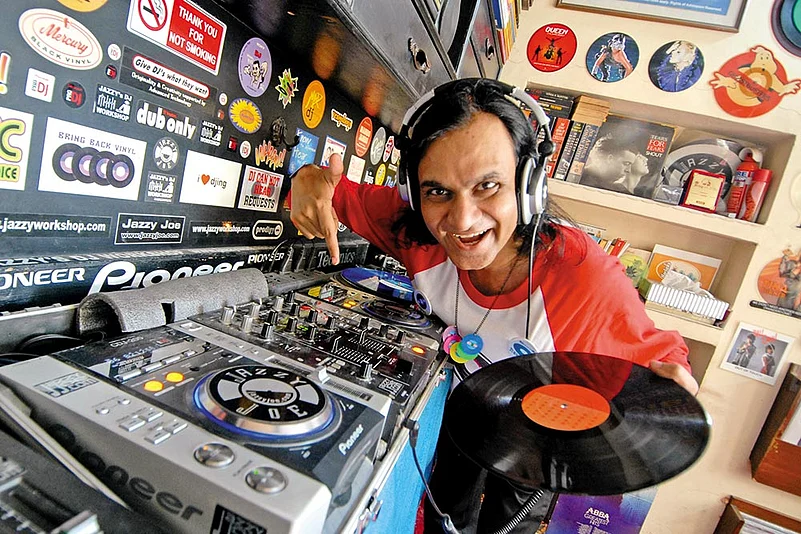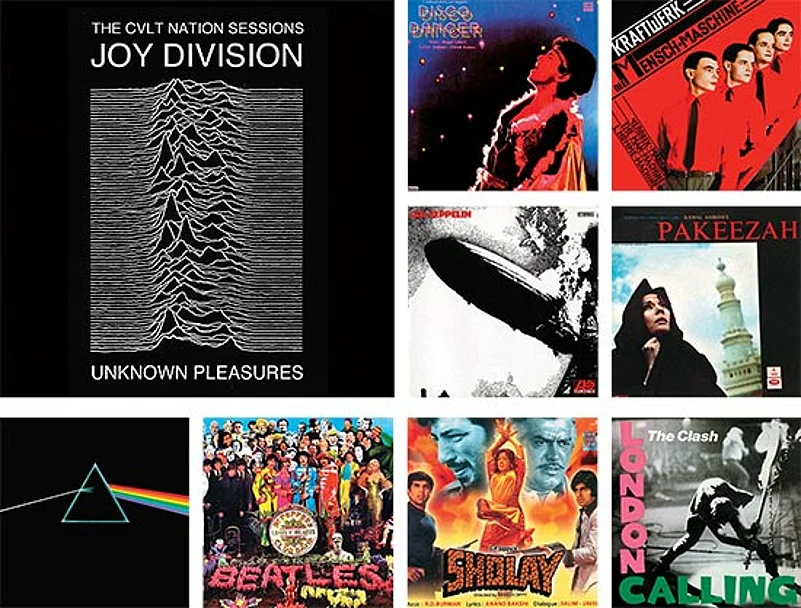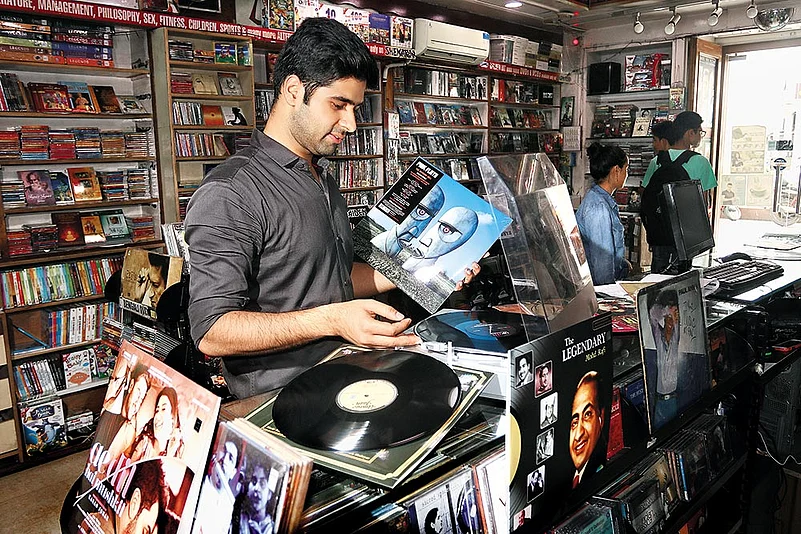Of all comebacks, none is as sonorous as this. Veteran ‘vinylhead’ Jaydeep Joy aka Jazzy Joe, hums a happy tune as his fingers flip through the scores of records lining the racks at Radio and Gramophone House, New Delhi. And one can imagine long-haired youths from long back dancing to the tune of Aao Twist Kare, as he lays the newly pressed record of Bhoot Bangla on the turntable, placing the needle gently into the groove. Jaydeep is not alone in being enthralled by the scratchy perfection of Long Playing or LP records. After market forces pandering to players ever more portable banished them for a generation, LPs—through which recorded music has been heard for most of its history of over a century—are slowly wresting back control. Leading the pack now are the new listeners, youngsters who are developing an ear for the warm, full-bodied sound of a gramophone record. And old connoisseurs are only too happy with this turn of the table.
According to Nielsen Music’s 2016 ‘US Year-End Music Report’, vinyl record sales reached an all-time high of 13 million units—an over 50 per cent rise from the year before. This is a 25-year high, since 1991, when Simply Red’s Star was the highest selling album. And here’s something more to listen to—2016 was also the first year that spending on vinyl records outstripped the amount spent on digital downloads. That alone must have sent studioheads into a spin, for, to keep up with the surge in demand, Sony has restarted production of vinyls after a 28-year break. If the passing away of music legends like Leonard Cohen, David Bowie, Prince, George Michael and Glen Frey last year gave a huge, nostalgic fillip to sales, the UK music body BPI shows that this is the ninth consecutive year that vinyl sales have grown, thanks to the growing awareness through events like Record Store Day and just an increase in shops selling records.
On April 22, 2017, India celebrated its first Record Store Day across Mumbai, Delhi and Bangalore. Delhi-based online music magazine Wild City celebrated with the inauguration of its ‘Selectors’ listening sessions, and Mumbai-based audio and vinyl shop, The Revolver Club, together with Sony Digital Audio Disc Corporation (DADC), took the lead in organising a blowout across Mumbai, Delhi and Bangalore. “It turned out to be bigger than we expected,” exclaims Jude D’Souza, one of the owners at The Revolver Club. “In all three cities, the participation exceeded a thousand at least,” he adds. The great shout back from listeners at the Wild City sessions has turned them into monthly sessions of listening to and understanding vinyl records.
Compared to the West, the return of LPs in India may still be at a nascent stage, but industry insiders believe that events like these, that are seeing substantial participation, are signs of a big revival, and so is a definite increase in the number of crate-diggers. “It is an almost 50-50 divide of old and new listeners now, so huge is the increase in interest already,” says Avinash Rajpal of the New Gramophone House in Chandni Chowk in Delhi. Though such a renascence is welcome news for music purists, does it have a whiff of retro snobbery, an exclusivity imported lock, stock and barrel from the West?

Vinylhead Jazzy Joe at his studio
“Indians have a habit of aping the West; it is one big reason for the vinyl revival in India, and a sure indication that it will get bigger,” says Sunil Jain, owner of the Radio and Gramophone House. Industry insiders believe that the interest in vinyl records among the youth has come from their peers, many of who have picked it up on trips abroad. Then there are the television shows like Vinyl on HBO, and documentaries like Our vinyl weighs a ton, I need that record and Red beans and rice have also stirred interest in ‘turntablism’. “I bought my first two records on my trip to the US, and have since been building my collection,” says 18-year-old Dvija Mehta. She now has over 40 records, and a second-hand turntable. She saves most of her pocket money for this expensive hobby, and requests for only records for gifts.
“It is an expensive interest to have,” admits Vikas Avasthi from Jabalpur. In less than four years he has managed to collect over 2,000 records, but says that he hasn’t spent over Rs 500 on any. New records can cost anywhere between Rs 1,500 to Rs 3,000, and the old ones can go as high as Rs 35,000 or more, like one Jain sold recently. “Many have been gifts, and others are a result of hours of crate digging and scouting,” he says. He scored 70 records off an old man who was looking to get them converted to CDS! Kaushik Shekhar, another collector, laughs resignedly at the sizable holes that the interest in LPs is making in his credit card statements. And he only has 40 so far.
So there are the inevitable hoarders or others who have a disposable income for quick buys, and do it for the sheer coolness that a turntable and a collection of old vinyl records bestow on the owner. Jain agrees that for a substantial number of buyers, it is this that is the draw. Again, for some, points out D’souza, it is the 12x12 artwork that comes with LPs, especially the classic ones, and designed by top artists and designers, that attracts. Indeed, Andy Warhol was behind the concept of the cover art of The Rolling Stones’ Sticky Fingers (1971); German painter Mati Klarwein created the surrealist art for Miles Davis’s immortal Bitches Brew (1969), while Jann Haworth and Peter Blake won the 1967 Grammy for ‘best album cover’ for Sgt Pepper’s. “Intricate artwork, like of Revolver and Sgt. Pepper’s, and most Hindi titles are collectors’ items in themselves,” he says.
But sales aside, industry insiders believe that a larger percentage of buyers of vinyl records are music lovers who are returning for the quality hearing that they offer. As some experts say, the supposed clarity of a long-playing record comes, ironically, from the ‘flaws’, or ‘harmonic distortion’, of the analogue as compared with the digital. Like Joy puts his stylus on the salient points, “it is the warm sound on the vinyl, the distinct feel of a myriad instruments, and the crackle of fresh voice that is the selling factor”. Rahul Soni, an author and a new vinylhead, believes that once a music lover has experienced the quality that LPs have to offer, there is just no turning back. “Plus it is good investment, because as collectors’ items, their prices are only going up.” Joy adds.
The turn in the fortunes of vinyl, then, also signals an upturn in the fortunes of the music industry. But what will be the share of vinyl records in these earnings, and where will the Indian vinyl industry be placed in the world of music at large are looming questions still. Vinyl records are projected to sell 40 million units globally this year, with sales nearing the $1 billion benchmark for the first time this millennium. And the release of new records of Amitabh Bachchan’s Don at the International Record Day shows that Indian music’s once large chunk of the vinyl pie can be served up too. The likes of Jain are even being consulted by Sa Re Ga Ma and T-Series for suggestions on what Indian music would sell best on vinyl. However, according to Deloitte, LPs will account for only 6 per cent of the estimated $15 billion revenue for the world music industry. For others like Mohammad Iljas, known as the go-to ‘dealer’ for LPs in Calcutta, there is no such thing as a vinyl comeback at all. “It is still only the collectors,” he says. In fact, he still sells records for as low as Rs 100 to Rs 250!
But veterans think otherwise. They say that the distinctive, rasping clarity, the palpable vibrations of sound waves that envelop listeners, and the exhilarating liberation of sound—say a swirling bass riff, or a stealthy entry of woodwinds—that lay buried and stifled for three decades through a ruthless urge to digitally compress would ensure new, mainstream success (for remember, LPs had never disappeared; a dedicated band of vinyl-only labels had kept the faith alive).

A smattering of great LP covers—Pink Floyd’s Dark Side of the Moon, Clash’s London Calling, Led Zeppelin, Sgt Pepper’s, Pakeezah, Sholay—shows why they are collectibles, while the English band Joy Division might one day be remembered solely for the great artwork of this album
Of course, sheer portability ensures that digital music is here to stay. Although the days of CDs (cassettes are ancient history) are numbered, musicon-the-go is a big part of music lovers’ regime, and Spotify still is a must for a long day, till they’re fortunate enough to come home and tuck in to the warm embrace of vinyl’s earthy sound.
















